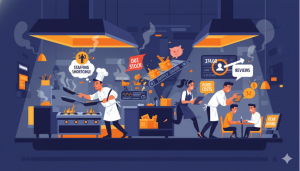Starting a small food business is comparatively a low-risk venture for startups.
Especially, if it’s the kind of situation where you aren’t looking for hot action right away, a small food business – and that too, on a budget, is much better than going all-in towards a restaurant venture.
Plus, if you ask me, the idea of lining the sidewalks every day with tasty delicacies is much better than sticking to a reservation and attending to customers all day. As a mobile small food business operator, you define your own work hours; you can drive around on a whim, and call it a day if you aren’t feeling it.
Fun Fact for Stat Nerds
BigCommerce experts suggest that the small food business industry oversaw a steady growth rate of 7.5% from the year 2016 – 2021. The trend is spiking upward, without showing any signs of regression.
Now is the ideal moment to delve into unique food business ideas, without any reservations. Consider ventures like gourmet coffee shops, artisanal ice cream parlors, health-conscious meal prep services, or even captivating bakery endeavors – the possibilities are yours to explore!

Alongside enjoying the many perks of running a small food business, it all comes down to the human interaction element. Since your audience isn’t scattered all over the city, you bond with your customers. Some of the regulars will become your friend, and, in turn, refer more people your way.
This post details a comprehensive breakdown of starting a mobile street small food business on a nominal budget. Don’t set out with high expectations as most millennials do. Stick with the plan, as described in this write-up, and results will come your way in due course of time.
Writing a Small Food Truck Business Plan
Capeesh?
Let’s go…
How to Start a Small Food Business on a Shoestring Budget:

Ideally, I’d say that this guide is best suited for small food business operators who don’t have too much investment, to begin with. If you already have a bunch of partners swooning over that fantastic multi-million dollar restaurant business plan that you guys made up over the weekend through a haze of doobies, you may as well skip this post.
On the contrary, if you’re in for brass tacks, and some real knowledge concerning how the mobile street small food industry works, keep reading.
Small Food Business 101 – Getting Investment!

Let’s be real here. You need money to start a small food business – or any other business for that matter.
Having a few dollars stashed up in the mattress will come in handy. However, if you’re are completely dry with a fantastic idea of starting a mobile street food “thingy” to begin with, it’s time to get some investment.
That being said, extra props go to you if your small food venture is based on a unique value proposition, such as; selling on a bunch of homemade food recipes that aren’t well known among common folks around you.
Here’s what will work best for you from an investment point of view:
Personal Loans:
Dish out loans from friends and family members who won’t give you a hard time if the business doesn’t fare well. Realistically speaking, you can haggle with your loved ones, as compared to putting up with professional debt collectors and the shenanigans that banks pull against small food business operators.
In the latter case, most likely, the collectors will hound you for money; banks will seize your property as collateral – so on and so forth. You can imagine the rest.
Community Sponsored Investment:
That’s one-up from the personal loans strategy.
Community people are always tied up together like a family. They’ll back you up, no matter what the cost. Starting a small food business, such as a mobile truck from community investment is a great idea. Everyone will pitch in; some people will give you microloans and you can pay them back via your very own installment plan.
The pressure will be manageable. Trust me.
Getting an Angel Investor:
Ugh… this one’s a bit of a doozy. Personally, I wouldn’t recommend signing any contract with an “angel” investor because you will owe money to the other party. They’ll have a say in profit share, and at some point, the investor will bank on all your hard work.
In common cases, where small food mobile street businesses hail from partnerships and investment parties, tend to scatter after a couple of months. There are legal litigations; external stakeholders will tell you how to run your business (*it’s the worst feeling ever), and you’ll have to abide by the investment repayment schedule.
Since small businesses are most vulnerable and unpredictable, at best, it’s not recommended that you go for any investment coming off of a bank, from “that guy who’s a friend of a distant relative”, an investment banker, and vice versa.
Still, if you are adamant and your friends and family don’t seem supportive, you can go for an agreement with an investor.
Have a solid contract template, and go for it.
Draw a fancy investment plan, and draft clauses to define payment terms, profit percentage, and loss equity, in case the small food business drives South, instead of up north!
Where Will Most of My Funds Go When Starting a Mobile Street Small Food Business?

Good question.
If it’s a food truck business, you have a couple of options, to begin with.
Rental Mobile Food Units:
A rental unit, such as a truck will come down to minimum payments of $2,000 – $4000. You can convert it into your local currency to see how the math works out. Regardless, rented food trucks, mobile kiosks, food rickshaws, etc. are a better idea in view of the net revenue you expect to generate at the end of each month.
- Brand-new vs. Used Mobile Food Units:
A brand-new food truck runs at a high ticket price of $75,000 to $100,000. Furthermore, you will need to make custom additions to it to create room for your kitchen equipment and other tools.
Likewise, a used mobile food unit will come around at half the price in the best-case scenario. If you already have rounded up enough cash, you can either buy a used mobile food vehicle or go for a new unit. The choice is yours.
If I were you, I’d go for a slightly used food truck, kiosk, or other mobile unit and spend the leftover cash on buying kitchen equipment, running a marketing campaign – so on and so forth.
- Kitchen Equipment, Food Ingredients, Utensils Etc.:
That’s where the remainder of your money will go.
According to ‘Restaurant MBA’ experts, kitchen items run up a hefty bill, right next to buying a food truck.
Potential small food business owners often overlook the cost factor associated with adding modifications to their mobile street food vehicles, kitchen utensils, and other equipment that’s equally important for running the entire operation.
Needless to say, don’t go all-in with buying all kinds of latest kitchen equipment. You only need a specific type of kitchenware that will help you to create your food menu. If you’re going to be flipping burgers and frying chips, then invest in a grill, frying equipment, and tongs in that order.
The miscellaneous kitchen and utensils are spread over:
- Pots
- Frying Pans
- Knife Board and set of Knives
- Food Storage Appliance
- Serving Implements, such as; Disposable cups, holders, plates, etc.
- Small Food Business License, Approval, and Permits:
Just because it’s a mobile food business wheeling around on a truck or some other means of transportation, doesn’t mean that you don’t need a permit. Many first-timers have the notion that they don’t need a permit because the food truck or a rickshaw can always be parked elsewhere when officials from the municipality kick in.
Fun Fact: Driving around a mobile food truck unit without a permit and government approvals is a very common ordeal in South Asian countries. In worst-case scenarios, these food operators grease a few palms and relocate their mobile food unit without further questioning from the concerned officials.
From a legal point of view, don’t look for shortcuts.
Get approval from the Board of Health and pay for a license to operate your mobile street small food business with peace of mind.
All the more, your customers will feel confident in knowing that you’re a legit business owner whose food is approved by the health regulatory committee, and vice versa.
To get approval for small food business from the U.S. Board of Health you need to have the following documents with you at the time of inspection from a random food inspector:
- Proof of identification
- Proof food equipment, food items, and mobile food unit purchase, rental, etc.
- Evidence of meeting fire code compliance
- Proper food storage units
- Copy of a district food manager identification card
If you are based in the Middle East, or somewhere in the MENAP region, contact your nearest food administrator to get started.
Up next, getting a license/ permit for your small food business is easy. You need to have the aforementioned documents with you. Visit your city’s website and navigate over to the compliance section for small food businesses to see how you can get the license.
If you don’t have a city website, then you need to contact officials at the health department in your city. Either way, they’ll fill you in on the prerequisites and the license/ permit cost. Since license cost for small food businesses, especially if it’s mobile, varies from one location to another, we can’t possibly list down the permit cost in that order.
Food Preparation 101:

If you don’t feel comfortable with cooking food, there’s no point in fiddling around with the ingredients in your mobile food unit. At best, your buns will be overdone, the egg may be well-done, and the salad will look as if someone threw up cottage cheese on a hot sidewalk.
Don’t waste time in the kitchen, unless and until you’re an expert. You’re better off with marketing and managing operations in the meantime.
To ensure that your food menu items are well prepared, visually attractive, and fresh, hire a chef. These guys don’t come in cheap, but you can get one on daily wages, or a monthly contract.
My personal opinion is to get a friend or a family member involved in the cooking process. They will not badger you for money, and you can negotiate with them a feasible payment plan without any hassles. Either way, getting access to a professional to help you with the food preparation process is crucial to scaling your small food business in the near future.
After all, beyond the glitz and glam of your food truck, it all comes down to the taste of your meals. If the customers don’t love it, you’ll have a hard time ahead.
In addition to the aforementioned antics, you need to create a process for perfecting the recipes on a loop. During rush hours, multiple orders are coming in from online and real-life customers. Make sure that the menu is repeatable in large quantities without any setbacks on the line.
A POS System for Small Food Businesses:
A point-of-sale system works like a charm for customers and small business owners at the same time.
From a customer’s point of view, POS system integration, allows him to pay for food through online payment methods, cashless takeaway modes, and QR payment codes. Plus, POS not only helps to fulfill online food orders but also assists in debiting the payment to the vendor account within a matter of few seconds.
[INSERT_ELEMENTOR id=”2061″]
Many traditional mobile street small food business operators refrain from installing a POS system. These vendors rely on a cash-only business model, which limits their ability to scale business for tons of people looking to place online food orders. It’s up to you though.
The good news for small food business startups is that Blink Co. offers such a POS system, alongside a value-added brand kit without any additional cost. Unlike conventional food services merchants, Blink will take care of your marketing campaigns, fleet management concerns for real-time order tracking, billing system, order fulfillment, and many other things.
Above all, the entire system is based on a monthly subscription payment plan that’s best suited for small-level restaurant owners and mobile food operators who aren’t comfortable with paying a flat commission against each order.
[INSERT_ELEMENTOR id=”2061″]
Before We Forget: Here are Some Important Do’s and Don’ts of Small Food Business for First-Timers:
Do’s:
- Come up with an innovative name and unique value proposition for your mobile food business.
- Keep your machine and kitchen equipment squeaky clean.
- Prepare in advance to handle large orders coming in during rush hours!
- You can play music to attract customers at a distance. Soon enough, people will notice your mobile food vehicle from miles before you are parked.
- Have an overall nice and cooperative attitude. If someone wants a custom food order for an entire office, go ahead and indulge the poor fella’. At best, he’ll be bringing in more customers.
Don’ts:
- At the end of the day, people will pay for your food menu. Keep it tasteful, fresh, and high-quality.
- Get a food permit from concerned authorities.
- Do not park your mobile food unit in handicapped space, or in areas where trucks are supposed to take a turn!
- Hired “help” is better than running a one-man operation.
- Do not overcharge your customers. You’re not running ‘The Ritz’. At best, it’s just another fancy mobile food business on the blip.
Consistency and Hard Work Does Pay Off:
Laura O’Neill is an up-and-coming small food business operator based out in the U.S.
She started small. With hard work, dedication, and collabs with wonderful business associates, like Pete Van Leeuwen and Ben, Laura is now overlooking a thriving food truck business with multiple locations and storefronts.
In her experience, food trucks, mobile units, and the integration of a POS system, such as; Blink Co. helped her to explore the full potential of her small food business. Today, she’s banking on her brand identity, and you can do that too.
Approach your business plan with a modicum of humility and consistency for the best results.
Good luck out there, Champ!
Related Articles:
 12 Innovative Food Ideas To Jumpstart Your 2023 Venture
12 Innovative Food Ideas To Jumpstart Your 2023 Venture
 What is a Point of Sale System and how Does It Work?
What is a Point of Sale System and how Does It Work?
 5 Free & Best Restaurant SEO Tips to Boost Your Online Presence
5 Free & Best Restaurant SEO Tips to Boost Your Online Presence
 Importance Of Restaurant Contactless Delivery & How To Implement It
Importance Of Restaurant Contactless Delivery & How To Implement It
 Top 8 Essential Restaurant Management System Features to Look For In 2022
Top 8 Essential Restaurant Management System Features to Look For In 2022




